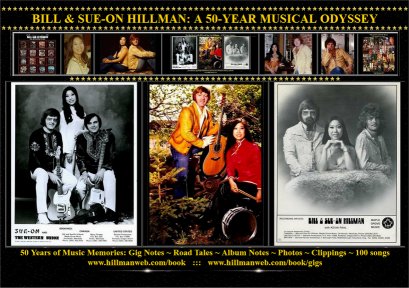CLIPPINGS ARCHIVE
Buddy Holly: 50 Years After The Music Died
February 3, 2009
Fifty years after his death at 22, rock 'n' roll
founding father Buddy Holly is still cool. On Feb. 3, 1959, Buddy Holly,
along with J.P. "The Big Bopper" Richardson and Ritchie Valens, died in
a plane crash while touring the Midwest. Holly would have been 72 by now
— and probably still rocking and rolling. Bob
Dylan, The
Rolling Stones, The
Beatles and Elvis
Costello have all paid tribute to Holly as a major influence.
But the music itself wasn't his only contribution. Holly
was among the first artists to use the studio as an instrument: He spent
days crafting songs and experimenting with techniques that were still new
in the recording business.
It worked. Buddy Holly and the Crickets shot to the top
of the charts just months after the band was formed in 1957. Elvis
Presley had the sex appeal, but it was Holly's boy-next-door charm
punctuated with horn-rimmed glasses and bow ties, as well as his Southern
drawl, that fans adored. Paul
McCartney, who in 1976 bought the rights to the entire Holly catalog,
remembers seeing him perform on a Sunday night in 1958 at the London Palladium.
The Beatles were huge fans. John
Lennon wore his horn-rimmed glasses "proudly," McCartney says — after
seeing Holly's trademark black frames.
'Peggy Sue'
By David C. Barnett ~ December 8, 2000
Buddy Holly was a skinny kid with glasses,
but in his short lifetime, he became one of rock 'n' roll's founding fathers.
Holly, who was known for his Stratocaster guitar and trademark hiccup style
of singing, influenced everyone from The
Beatles to Bob
Dylan. As part of the NPR
100, a list of the most important American musical works of the 20th
century, WCPN's David C. Barnett has the story of one of Holly's biggest
hits, "Peggy Sue."
Before Buddy Holly became an international rock 'n' roll
star, he was a local hero in Lubbock, Texas. That's where Niki Sullivan,
who later became Holly's rhythm guitarist, first heard him play. "We used
to go to the skating rink and watch him perform," Sullivan says. "Or if
he were performing in a live show, say at an opening of a car dealership
and things like that, that's how we were getting hooked into music. Because
all we had to listen to in those days was the big-band music and, being
in west Texas, mostly country and western."
Country & Western
Charles Hardin "Buddy" Holly got his start in the music
business singing country and western songs. A Decca Records talent scout
caught his act at the skating rink one day and signed him to a limited
recording contract.
In a Nashville studio, Holly was given three chances to
sell record executives on his music. But they weren't too crazy about his
blend of rockabilly tunes with more traditional country ballads. Holly
had especially high hopes for a song that he and his drummer pal Jerry
Allison had written based on a line from the 1956 John Wayne film The
Searchers: "That'll Be the Day."
Norman Petty
Jerry Allison recalls being nervous recording under the
strict rules of famous Nashville producer Owen Bradley. He says it contrasted
greatly with the laid-back attitude of Norman Petty, who'd recorded some
demo tracks for them in a small studio he ran in Clovis, N.M. After the
tense sessions in Nashville, the musicians decided to record exclusively
with Petty, and the results of that relaxed atmosphere were immediately
evident.
In between short tours of the region, The Crickets' members
spent most of their time at Petty's studio. They worked long hours, sometimes
sleeping there overnight rather than make the 100-mile trek back to Lubbock.
Sullivan says Petty was a perfectionist, in spite of the imperfect conditions.
"When you hear those recordings, you're hearing one of the cleanest, crispest
sounds ever," Sullivan says. "And it's amazing that he did it in Clovis,
N.M., next to a highway that ... Frequently, we were interrupted by trucks
passing because [of the] rattling windows."
Cindy Lou
It was during one of those sessions in the summer of
1957 that Buddy Holly, bassist Joe Mauldin, rhythm guitarist Sullivan and
drummer Jerry Allison began to work out one of their biggest hits. "Buddy
had a song started called 'Cindy Lou,' " Allison says. "I think he had
a niece named Cindy Lou, or Cindy, but it was sort of like, 'Cindy, oh,
Cindy / Cindy don't let me down.' That Harry Belafonte kind of feel. 'Cindy
Lou, Cindy Lou / Oh, how my heart yearns for you, oh, Cindy.' " Sullivan
says Petty was not impressed. "Norman says, 'Well, that cha-cha beat isn't
going to work,' " Sullivan says. "He says, 'You're going to have to do
something else,' and that's when Buddy said, 'Jerry, why don't you try
paradiddles? It'll give us a four-four beat. We'll speed it up a little
bit.' "
A paradiddle is a basic practice pattern for a drummer;
it involves rapid strokes, which create a rolling sound. Allison agreed
to the modified rhythm, and suggested one more change. "I had a girlfriend
at the time named Peggy Sue, so I talked him into changing it to 'Peggy
Sue,' and then we finished it with a different feel," Allison says. "You
know, like the straight 8s, kind of, 'If you knew / Peggy Sue.' " The result
creates a relentless rhythm that keeps rolling at the listener. Petty accentuated
that effect by playing with the reverb.
A Sense Of Joy
"They kind of used the studio in the '50s the way people
like The Beatles started to use it in the '60s," guitarist Marshall Crenshaw
says, "which was a sort of combination laboratory and playground." Crenshaw,
who was 4 when he first heard Buddy Holly, says he was hooked by the energy
in the music. "There's a real sense of joy in almost everything that he
ever recorded," Crenshaw says. "And everything about those records appealed
to me when I was a kid, the way he played the guitar. You know, he'd just
make the whole thing ring, you know, and it just sounded very celebratory
and just made me really happy and excited."
But for all the guitar technique, all the percussive experiments
and Holly's unique hiccup style of singing, Allison says there wasn't any
master plan to be on the cutting edge of anything. "Nah, we just hoped
somebody would buy our records so we could go on the road and play," he
says.
On The Road With Peggy Sue
When they took "Peggy Sue" on the road, Sullivan says
the reaction was electrifying. "We were in Idaho. Of all places to break
a song was in Idaho. Those kids jumped up and went crazy with 'Peggy Sue,'
and we don't still know — I mean, the ones of us remaining still wouldn't
be able to tell you if it was the song or it was the combination of songs,
or kids just needed an outlet. But whatever it did, it worked."
And not because of the lyrics, either. "When you listen
to that song," Allison says, "tell me what in the world — why anybody would
buy a song with those lyrics. But it's the interpretation that comes across
and that driving rock, and it just bites you, you know?"
Since its release, the song has sold more than 5 million
copies. But Buddy Holly had no idea just how long the music that he helped
create would last, and it seems he didn't really think it should, as revealed
in a 1957 interview with Canadian disc jockey Red Robinson.
Red Robinson: What do you think about rock 'n'
roll music? How long do you think it will last: another six months, seven
months?
Buddy Holly: Oh, possibly, yeah.
Robinson: Think after Christmas things may change a bit,
then?
Holly: It might pick back up, but I really doubt it.
I'd prefer singing something a little more quieter anyhow.
Holly historian Griggs to be inducted into
West Texas Walk of Fame
Bill Griggs, internationally respected Buddy Holly
and rock ’n’ roll historian,
will be inducted into the West Texas Walk of Fame
at 6:30 p.m. today.
Lubbock
Online ~ July 30, 2010
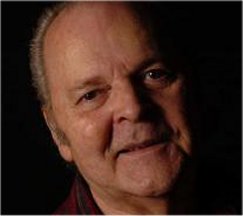 “The
Buddy Holly Story” is not William Frederick “Bill” Griggs’ favorite movie.
In fact, that 1978 movie would not stand a chance even if the filmmakers
responsible had gotten their facts straight. Instead, the sentimental Griggs
remains particularly fond of “It’s a Wonderful Life.” Now being treated
for stage-4 cancer, Griggs, 69, maintains an extremely positive attitude,
yet mentions more than once that he, too, has enjoyed a wonderful life.
He said physicians give him “nine months to a year — or who knows, maybe
longer (to live).” “The
Buddy Holly Story” is not William Frederick “Bill” Griggs’ favorite movie.
In fact, that 1978 movie would not stand a chance even if the filmmakers
responsible had gotten their facts straight. Instead, the sentimental Griggs
remains particularly fond of “It’s a Wonderful Life.” Now being treated
for stage-4 cancer, Griggs, 69, maintains an extremely positive attitude,
yet mentions more than once that he, too, has enjoyed a wonderful life.
He said physicians give him “nine months to a year — or who knows, maybe
longer (to live).”
Griggs, respected internationally as a music historian,
will be inducted at 6:30 p.m. today into the West Texas Walk of Fame. His
name will be placed on a plaque near a statue of Buddy Holly, the man whose
life Griggs spent years researching. “I can claim good friends in 34 different
countries,” he said. “My life has been wonderful.”
Cachet envelopes commemorating today’s induction also
will be sold; proceeds benefit the South Plains Stamp Club. It was only
a year after Holly’s statue was unveiled that Griggs moved from Connecticut
to Lubbock. Griggs would later say, “Buddy was gone by then. But everyone
else was still here. So I got here as quick as I could.”
He first visited Lubbock in 1968 on vacation, then moved
here permanently in 1981. Not being from Lubbock originally helped him
maintain an objectivity, he said, when reporting about Holly and other
West Texas musicians. For that matter, Griggs also pointed out that he
never placed Holly on a pedestal of any sort. He began reporting on Holly,
he said, because, “I didn’t see anyone else doing it.”
When he founded the international Buddy Holly Memorial
Society in 1975, operating under an agreement with the Holly estate, he
lost track of the number of people who told him, “I thought I was the only
fan left.” Within 15 years, BHMS membership totaled more than 5,500 in
50 states and 34 countries.
His memorial society gave way to publishing Reminiscing
magazine. Griggs later focused on a monthly magazine called Rockin’ 50s,
which he published through 2004 and also became the name of his business.
A career highlight was his publication of a five-booklet set, “Buddy Holly
Day-By-Day,” in which Griggs documented where Holly was, and what he was
doing, on all but a dozen dates during the artist’s entire career. Seven
years of research were required for the 1998 project.
Griggs has lured a significant number of international
visitors to Lubbock. He also was intent on exposing Lubbock’s younger generation
to its most famous native son, and gave multiple speeches at Lubbock schools
at the request of city officials. Griggs mentioned this week that he actually
became a fan of the Crickets before Holly. (“That’ll Be the Day,” he said,
initially was credited to the Crickets.) He first became a fan when he
heard the Crickets make “a smooth tempo change, never missing a beat,”
during that particular song, something he’d never heard young rock musicians
even attempt.
Griggs saw the Crickets (and Holly) perform live twice
in the 1950s, the first time with member Niki Sullivan and the second after
he had left the band. More than two decades later, in 1978, it was Griggs
who reunited all of the Crickets on stage for the first time since 1957.
He has been interviewed by every major news and music network in the United
States and England.
He received three gold records from MCA Records for help
in maintaining the authenticity of Holly recordings and at times writing
liner notes. For example, Griggs was hired by the Buddy Holly estate in
2000 as a consultant to visit MCA Records in Los Angeles, listen to all
of its Holly tapes and explain when, and where, each was recorded, and
also what artists are performing on each version of every song.
In 1994, Griggs published a reference book “A Who’s Who
of West Texas Rock ’n’ Roll Music,” which included details about almost
100 West Texas solo artists and groups from the 1950s and early 1960s.
Randy Steele, who campaigned for eight years for Griggs
to be inducted into the Walk of Fame, will introduce him today. Steele
said, “Bill covered his music subjects like a ‘fan’ would cover them, and
he asked the questions to find answers that a ‘fan’ would want to know.
As a result, we learned intimate details about the events that shaped West
Texas music, and we learned the stories of the people who made that music.”
John Pickering of the Picks, the group that recorded background
harmonies for Holly and the Crickets, stated, “When (Griggs) found the
Picks in 1981, we were scattered and had given up on anybody ever knowing
that we sang with Buddy Holly. We figured that nobody cared. ... He brought
all three of the Picks together again in 1982 for the 25th anniversary
of our recording sessions with Buddy Holly.”
And Ryan Vandergriff, author of a soon-to-be-published
book about Holly’s final tour, said, “Quite simply, Bill Griggs has acted
as a major promoter for the city of Lubbock for would-be travelers who
ever had even the smallest notion of visiting (Lubbock). “He has done such
a wonderful job of promoting hometown-boy-made-good Buddy Holly that Lubbock
has become one of the more recognizable cities in America.”
Griggs induction
•Attraction: Induction of music historian/writer Bill
Griggs into West Texas Walk of Fame.
•When: 6:30 p.m. today.
•Where: Site of the Buddy Holly statue, presently located
in the middle of Eighth Street, west of the Lubbock Memorial Civic Center,
•Admission: Free.
•After induction: Music will be played for approximately
30 minutes by Jack Neal, the late Buddy Holly’s original singing partner,
and George Tomsco, formerly of the Fireballs and a 2001 West Texas Walk
of Fame inductee.
|


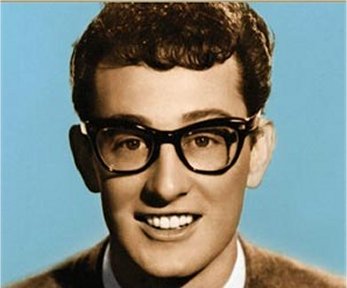
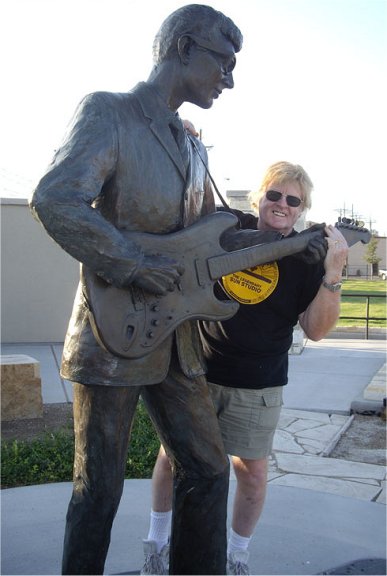
![]()




![]()
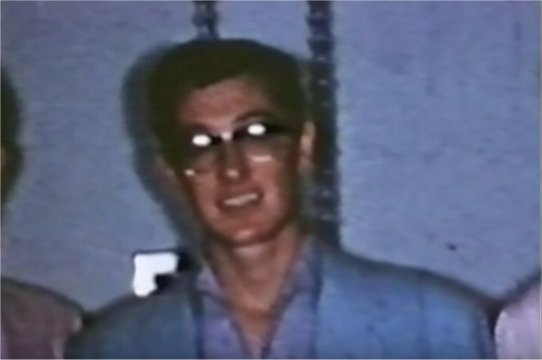
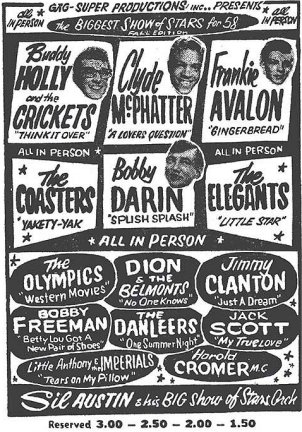
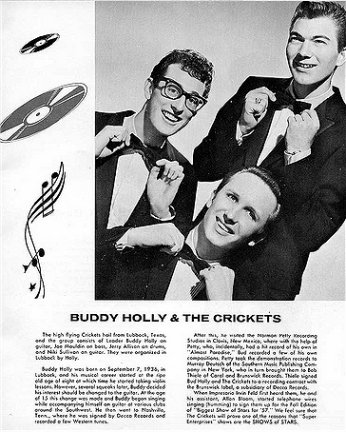
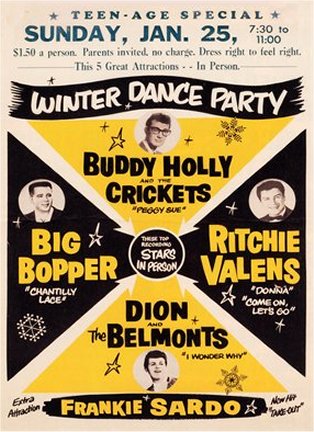
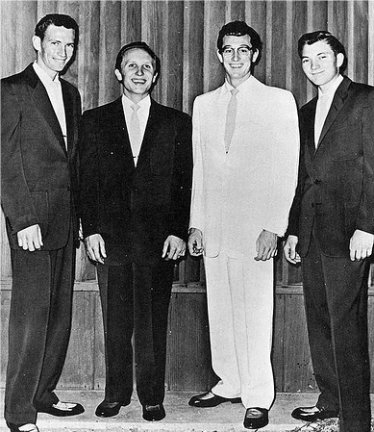 .
.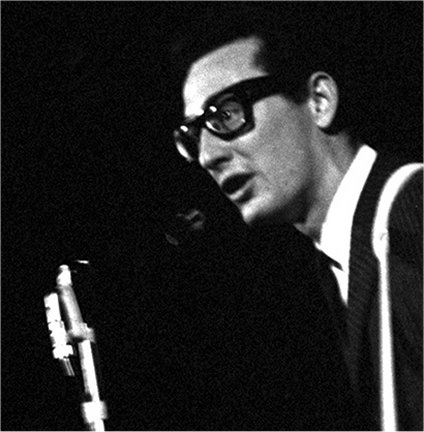
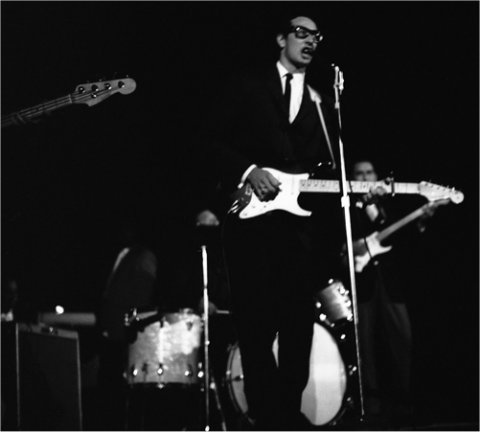 .
.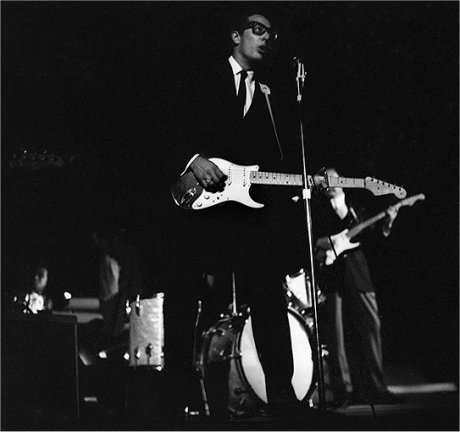
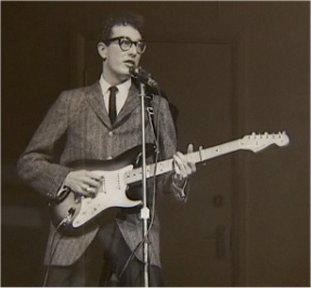
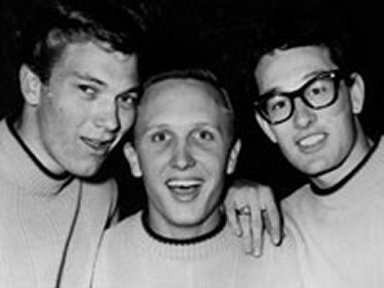
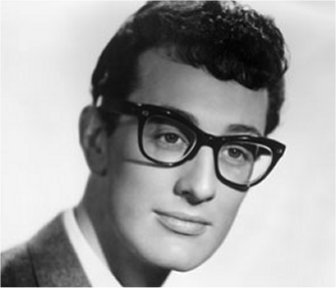
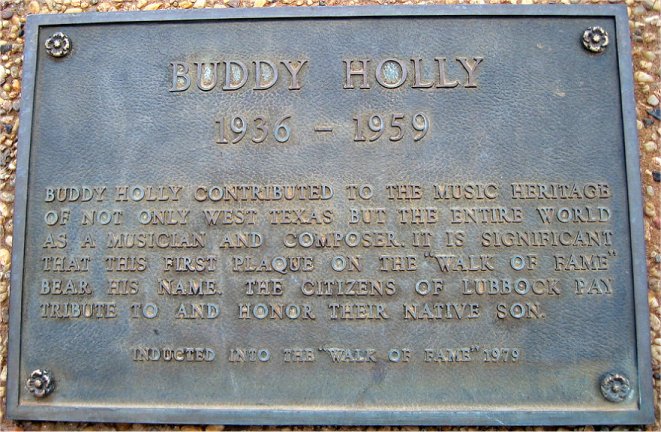
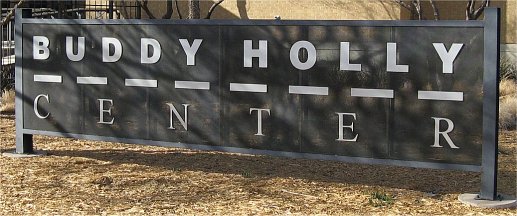
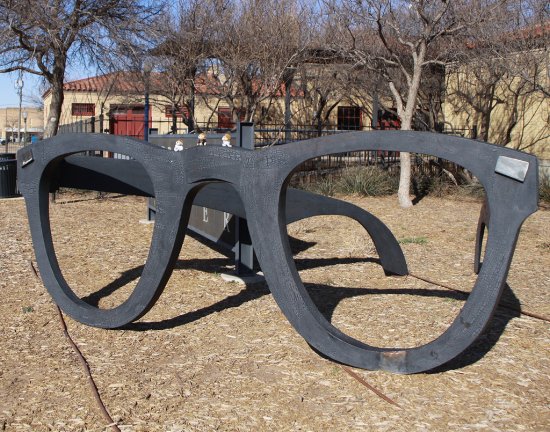
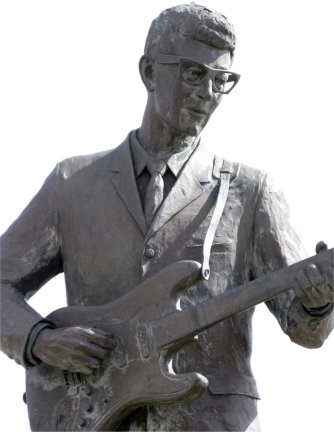

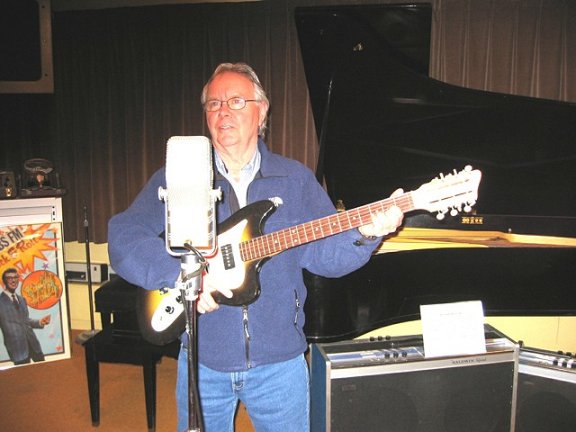

![]()
![]()
